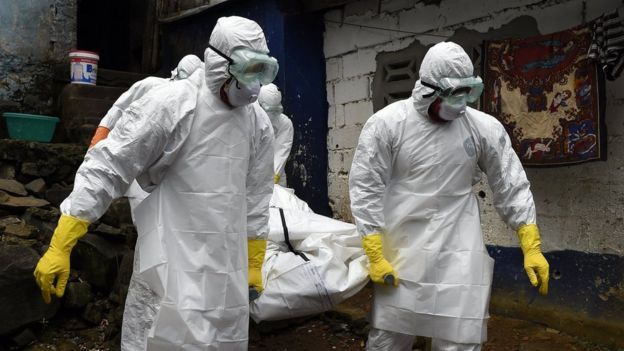Disease Super-Conductors
"It's similar to looking at a blood spatter pattern and figuring out where the shooter was standing."
"Superspreading was more important in driving the [Ebola] epidemic than we realized."
"[Public health authorities should think about] What are the scenarios where superspreading might occur [in future epidemics to help in protocols leading to outbreak controls]."
Benjamin Dalziel, assistant professor, population biology, Oregon State University
 | ||
| Monrovia, Liberia, was hit hard during the 2014-2015 Ebola epidemic in West Africa. (Zoom Dosso/AFP via Getty Images) |
Random contamination within a community is one thing that nature has designed where infectious diseases become epidemic in nature. Another, apparently, is to nominate individuals through their biological genetic inheritance as carriers of infection, people who, through no fault of their own and unbeknownst to themselves actually are involved in spreading infection on a wide scale. These people have been labelled "superspreaders".
This minority of people whom science recognizes have been vectors whose presence spells a large-scale increase of the number of people whom morbidly infectious diseases strike, thus spreading the reach of the disease much beyond any other process is capable of doing through the process of contamination and infection. Scientists engrossed in a study to comprehend how it was that Ebola spread so rapidly in the 2014 -- 2015 epidemic in West Africa, concluded.
New research has led to the discovery that a large role was held by superspreaders; findings recently published in the Proceedings of the National Academy of Science. Now, it is understood that had there been control of superspreading, close to two-thirds of the resulting infections could have been avoided, according to scientists. Obviously, candidates for superspreading would have had to be identified and isolated from vulnerable populations.
Over 28,000 confirmed, probable and suspected instances of Ebola had been reported during the outbreak in West Africa, resulting in over 11,000 deaths, according to the World Health Organization. That is a huge mortality percentage for any infectious disease, explaining more than adequately just why the medical community worldwide was on such tenterhooks and local health authorities felt helpless until the Ebola epidemic was well in hand.
A retrospective analysis of the timing and location of 200 community burials, taking place between October 2014 and March 2015 in urban areas around Freetown, Sierra Leone was undertaken by researchers from Princeton University and Oregon State University. With the use of a mathematical model the transmission network was reconstructed to determine the proportion of cases caused by superspreaders.
 |
| Getty Images -- a dead body carried on a stretcher by nurses wearing protective clothing |
The estimate was that roughly three percent of infected people had been responsible for the infection of around 61 percent of resulting cases. That pattern was detected as well in Guinea and Liberia which, aside from Sierra Leone, represented the three countries hardest hit by Ebola. Children under age 15, or adults between the ages of 40 and 55 were those identified as within the superspreader community who spread the disease in their communities.
From the communities those who were first infected went to treatment centres and there transmission was under much improved control. And it was not only Ebola where superspreaders were seen to have played a major role in transmission of infection, but in the 2002 - 2003 outbreak of severe acute respiratory syndrome (SARS), one of the features of the outbreak was its transmission by superspreaders.
To the extent that in Hong Kong, a 26-year-old patient who had been admitted for treatment to a hospital, himself infected another 156 people, that number inclusive of hospital staff, patients and visitors.
Labels: Bioscience, Epidemic, Health, Infection, West Africa

0 Comments:
Post a Comment
<< Home